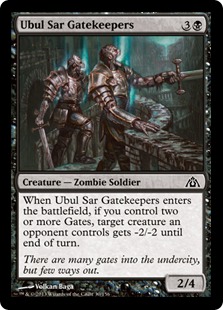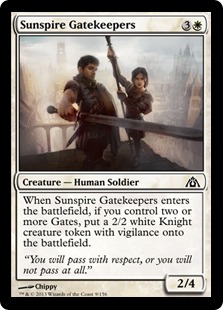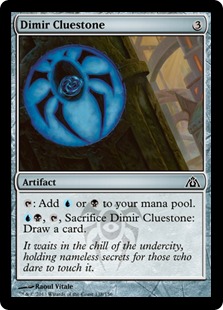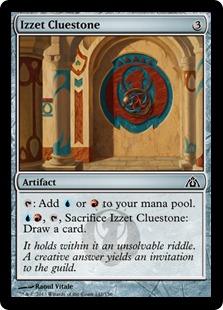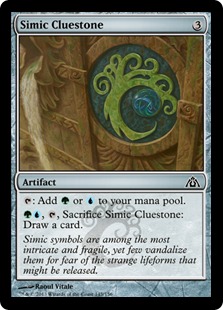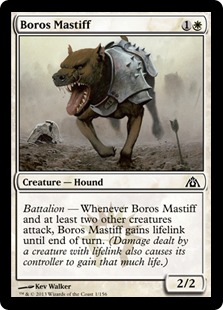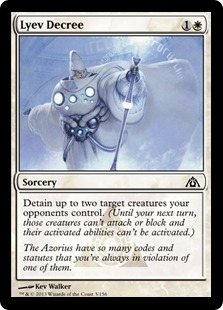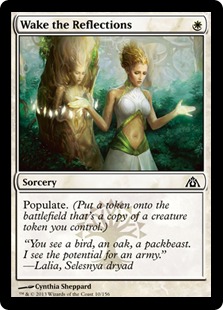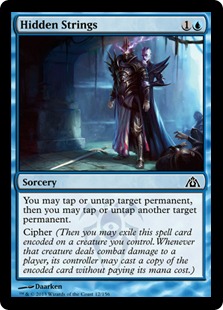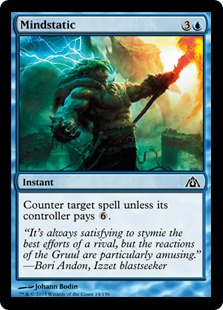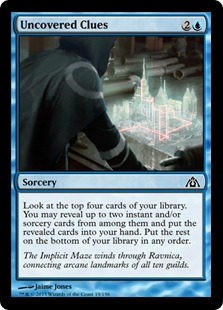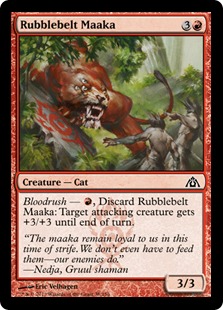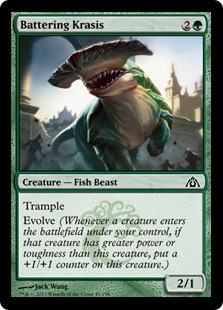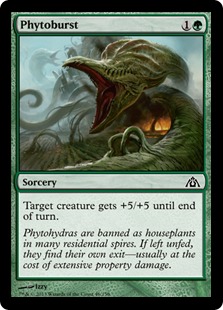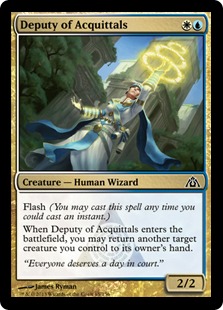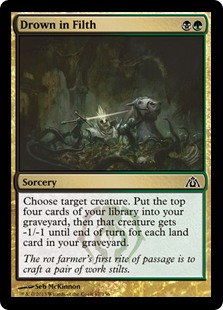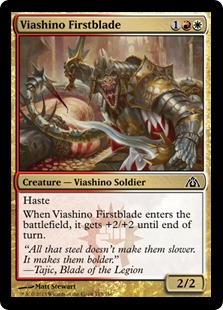The final installment of Return to Ravnicablock has been unveiled, and Dragon’s Maze gives us something that Magic players, Pauper and non alike, can appreciate: options. The fact that Dragon’s Maze was designed to facilitate ten guilds put rather tight constraints on the commons that could be made available. That being said, the last set in our return to the city plane is a fully stocked hardware store for the common mage. A quick note—I will also be providing my take on cards for Standard Pauper this time around, as that format is starting to pick up more steam.
Examining tight cycles first, the Gatekeepers appear to be tailor made for Pauper. Reasonably costed creatures with enters the battlefield abilities show up regularly (see Chittering Rats, Mogg War Marshal, Keldon Marauders, Mulldrifter, etc.). However, the condition of having two Gates in play is a fatal blow to the cycle. Few Pauper decks run Gates, and in order for these to be played on the optimal turn, any two of turns 1 through 3 would have to be devoted to developing a potential turn 4 play. The payoff of these cards is not nearly high enough to make the Gatekeepers, sure to be Limited all stars, anything but fringe Pauper playables.
Even in the smaller card pool of Standard Pauper (where these cards are getting more press on forums like pdcmagic.com), I still would rather have a sure thing than a “maybe” effect. While the Gates are much more prevalent in the smaller format (as are Ghostly Flicker value decks), I am always more inclined to be pressing an advantage with attacking. In Standard, my favorite is Ubul Sar Gatekeepers, as it can brick most attackers while occasionally taking out another. My second favorite, Sunspire Gatekeepers, accomplishes something similar.
The Cluestones are another beast altogether. Signets see play from time to time, and the Cluestones are similar in that they help accelerate, albeit with a delay of a turn. Where the Cluestones shine is in their ability to be turned into a live card late in the game. This could be huge for control decks. At the moment, most control decks run the big mana engine of Cloudpost, so the need for ramp is mitigated. It is not beyond the realm of possibility that the Locus engine will be neutered at some point.
If that time comes, control decks might look to the Cluestones as a supplement to other mana rocks. The jump from two to four (via Signet) is much more important than the jump from three to five because more critical card advantage drops (Sea Gate Oracle and Compulsive Research, for example) are turn 3 plays, directly competing with a Cluestone. As with the Gatekeepers, I expect the Cluestones to see more serious play in Standard Pauper as supplements to Prophetic Prism.
Boros Mastiff is reminiscent of Daring Skyjek in that both are two-drops that encourage attacking, but Daring Skyjek has two big advantages: an extra point of power and conditional evasion. In White Weenie, triggering battalion is fairly easy thanks to Squadron Hawk and Doomed Traveler providing fodder. The more likely three points of damage from Skyjek is more enticing than a four point life swing, especially in a format as fast as Pauper. If the format turns towards aggro mirrors where life totals matter, I could see Mastiff getting the nod. As is, it is a nice addition to the smaller card pool of Standard.
Lyev Decree is quite the Falter. Not only does it prevent them from blocking, but it also Fogs two attackers on the next turn. While most of the aggressive decks in Pauper will have more than two creatures at any one time, this is still an effect to keep in mind, as it has not existed before at two mana and Blinding Beam is quite expensive given the current speed of Pauper.
Wake the Reflections has garnered a lot of attention. In the best-case scenario, it’s a one mana Clone; worst case it reads W: do nothing. The average is somewhere in between, but towards which extreme does Wake trend?
This largely depends on the best tokens available in Pauper. While Centaur’s Herald and 3/3 tokens are the go to for Return to Ravnica block, going a bit further into the past reveals Zektar Shrine Expedition and Giantbaiting as commons that generate some very exciting tokens. The 7/1 from Zektar Shrine is rather fragile, so let’s focus on the more hardy 4/4 Giant. Giantbaiting has the added bonus of Conspire, meaning it will generate two tokens and would require two counters to stop entirely. It’s not unreasonable to imagine Conspiring a Giantbaiting and then spending the extra mana for Wake the Reflections to keep a third token around for the long haul.
Imagine a core of:
4 Avacyn’s Pilgrim
4 Nettle Sentinel
4 Quirion Ranger
4 Ivy Lane Denizen
4 Centaur’s Herald
4 Giantbaiting
4 Wake the Reflections
There is still the red option. Boros lacks the untapping goodness of the Nettle Sentinel and Quirion Ranger but has the added bonus of Kruin Striker and Foundry Street Denizen to acquire some extra power to the attacking army. Mogg War Marshal also plays nice here, providing the conspiracy all on its own:
4 Foundry Street Denizen
4 Kruin Striker
4 Doomed Traveler
4 Mogg War Marshal
4 Goblin Bushwhacker
4 Giantbaiting
4 Wake the Reflections
While these decks clearly operate in the “best-case” realm, the presence of Giantbaiting makes it far more likely for Wake the Reflections to actually have rules text. This is quite the one mana spell and is likely to fuel many brews for years to come. So which way does Wake the Reflections trend? I am cautiously optimistic that it will be more Clone than a blank.
The next card shows that combo will be a part of the Pauper metagame for the foreseeable future. Hidden Strings might be a slick combat enabler in Limited, but in Pauper it has one job: to untap lands that produce more than one mana. For our purposes, cipher might as well not exist (but oh, does it ever matter). One current breed of combo utilizes cost reducers like Sunscape Familiar, lands such as Izzet Boilerworks, the duo of Cloud of Faeries and Snap (or Ghostly Flicker,) and Mnemonic Wall (or Archaeomancer) to generate an arbitrarily large amount of mana. It works like this:
1) Have two cost reducers in play alongside two lands that produce more than one mana.
2) Cast Cloud of Faeries for U (tapping two lands) and untap them, netting three mana.
3) Snap the Cloud of Faeries (tapping the two lands again), netting another three mana OR cast Ghostly Flicker on Cloud of Faeries and Mnemonic Wall to untap the lands again while retrieving the Ghostly Flicker and repeating. If using Snap, start targeting a Mnemonic Wall and recast said Wall, targeting Snap in the graveyard, and repeat.
4) Profit (via a Kaervek’s Torch or Temporal Fissure).
Hidden Strings plays nicely into this in that it will have its cost reduced and then untap the lands (a la Snap). Even better, it can be used to tap down opposing lands to prevent interaction. Finally, if you so choose Strings can be encoded onto a Cloud of Faeries (likely to attack the next turn) and repeat the process (or, y’know, you could just let it go to the graveyard and Regrow it with a Mnemonic Wall).
In conjunction with a card like Goblin Electromancer, it is reasonable to imagine an Izzet flavor of the combo:
Creatures (12)
Lands (22)
Spells (26)

Switching gears to a land far more fair, what happens when you multiply Mana Leak by two? You get Mindstatic. While Classic has clear better options (namely Mana Leak and Counterspell, but also Prohibit), Standard Pauper could benefit from having a late-game stopper.
As if Storm wasn’t good enough already, Uncovered Clues gives the deck another tool. Digging four deep is great, and being able to net two cards while also shipping chaff is fantastic. While it may not find a slot in current combo decks (since they are largely creature based), it stands to reason that this card could find a home in variant builds moving forward.
Uncovered Clues also has a use as a supplement to Mystical Teachings in control decks. Sure, it cannot find you exactly what you want, but the ability to get two answers (or draw spells) and again, getting rid of the detritus, can be huge in control mirrors. Now control decks can skew the numbers on sorcery speed all-stars like Innocent Blood, Flame Slash, and Firebolt lower while running more effective copies with Uncovered Clues. It also provides a strong draw engine for Standard Pauper control decks that might want to be fighting the onslaught of Ghostly Flicker card advantage (or just help the deck uncover its own copies of Flicker).
As a long time proponent of Viscera Dragger, I am a firm believer in the power of 3/3 creatures with some upside in Pauper. Rubblebelt Maaka continues this tradition. A Hill Giant is bigger than just about every normally played creature in Pauper and wins nearly every fight that does not include a pump spell. But the real upside comes with the attack only Giant Growth—I mean Brute Force. This option provides non-Goblins red decks with a decent top of the curve creature or early game way to trade up or punch through damage. While I do not expect this card to make huge waves (in either version of Pauper), it should see play and is a good bet to end games.
Battering Krasis is another one of those “likely for Standard, unlikely for Classic” cards. Garruk’s Companion is just a more reliable option in Classic and Battering Krasis is unlikely to ever get larger than its core set compatriot. However, Companion is currently not Standard legal, so this whatevertheheckitis could see play. An interesting spot for it could be in a dedicated evolve deck:
Creatures (26)
- 3 Stormbound Geist
- 4 Young Wolf
- 1 Mist Raven
- 2 Voidwielder
- 4 Cloudfin Raptor
- 4 Shambleshark
- 4 Slaughterhorn
- 4 Battering Krasis
Lands (24)
Spells (10)

Another way to increase a creature’s power might breathe life into an ailing archetype. Without Invigorate, Infect has fallen on hard times. While still a valid deck, it lacks the ability to kill nearly as quickly and is merely a “fair” combo-aggro deck. Phytoburst might change all that. Since its creatures largely ignore toughness anyway thanks to Rancor, the ability to give an effective +10 power for two mana should be enough for the not quite as sick monsters of Infect to do their work.
I am going to mention Beetleform Mage just so I can note that this guy has the creature types of both halves of Delver of Secrets and is not nearly as good of a card.
Deputy of Acquittals is sure to make waves in Standard Pauper, where the utility of enters-the-battlefield creatures is far higher than Classic. On the senior circuit, Deputy of Acquittals is the best Ashcoat Bear available. Not only does it come down on their turn 2 (letting you leave up Prohibit or Mana Leak or maybe even Counterspell mana), but it has utility in the later game by resetting Mulldrifter.
Unlike all-star Kor Skyfisher, this Azorius bear can also flash in midcombat to save a key creature. Even with all these positive attributes, the bar for entry into Pauper is so high that Deputy of Acquittals is likely to only see fringe play (unless the format slows considerably). Standard Pauper, however, will make better use of Deputy of Acquittals, acting as a supplement to Ghostly Flicker while also providing pressure all its own.
Drown in Filth is a card I do not expect to see much play at the moment. That being said, it is a strong enabler for graveyard decks if such a thing ever finds a way to exist in Pauper. If it does, I could see Drown in Filth pulling double duty as occasional removal spell and engine.
Nivix Cyclops is what happens when Wee Dragonauts grows up. Always a fringe deck, Wee Dragonauts had found a kindred spirit in Kiln Fiend and an odd cousin in Delver of Secrets. These decks wanted to cast lots of spells and crack in for tons of damage. Ponder, Preordain, Laval Dart, Assault Strobe—these cards made single attacks lethal. Nivix Cyclops has the same power boost as Kiln Fiend and better defensive positioning. With a critical mass of unblockable effects—Shadow Rift, Distortion Strike, and Artful Dodge— the Wee Fiend decks might reach a point where they abandon their namesake entirely for what is surely some of the best art on a common in quite some time.
On to another gold card. If you’re a reader of my articles, you know I revisit Nightsky Mimic with some regularity. With a critical mass of Orzhov spells, the Mimic becomes an unparalleled finisher for its cost. The release of Tithe Drinker leads me to believe that the critical mass has been reached. To wit:
Creatures (25)
- 2 Blind Hunter
- 4 Nightsky Mimic
- 4 Nip Gwyllion
- 3 Kor Skyfisher
- 4 Vault Skirge
- 4 Kingpin's Pet
- 4 Tithe Drinker
Lands (23)
Spells (12)

The above deck is hyperlinear but showcases just how powerful Orzhov can be in Pauper. Only two spells in the entire deck do not trigger Mimic, and one goes a long way towards furthering extort or making Mimic a 4/4. Much like after Gatecrash when I took a swing at such a deck, I’m sure come Dragon’s Maze I’ll be doing the same.
At the end of the list, we come to the first. Viashino Firstblade is one heck of a creature. It attacks as a 4/4 the turn it comes into play, and if it survives (which it should), it comes back as a 2/2—all for three mana. That is a pretty good rate. Its utility as a way to trigger battalion will likely be confined to Limited and Standard Pauper. In Classic Pauper, it provides what may be a key piece to a competitive Boros deck. It’s not traditionally a color combination that values Flicker effects, but given a large enough cardpool, well, anything is possible:
4 Doomed Traveler
4 Keldon Marauders
4 Mogg War Marshal
3 Kruin Striker
2 Wojek Halberdiers
2 Goblin Bushwhacker
3 Kor Skyfisher
4 Viashino Firstblade
4 Inner-Flame Acolyte
4 Cloudshift
4 Lightning Bolt
On the surface, you are just a straight up Boros deck, attacking and trying to set up a potentially lethal attack with Goblin Bushwhacker. However, Cloudshift adds a layer. Now, Inner-Flame Acolyte becomes six potential power for the same cost as Martial Glory. If you evoke the Acolyte targeting a Keldon Marauders, for example, then Cloudshift with the sacrifice trigger on the stack, and it comes back into play targeting itself.
Cloudshift also allows Viashino Firstblade to reset if you ever need a 4/4 again (not sure why anyone would need that…). This deck might want to lean harder on the rebuy scheme and add a Whitemane Lion or could look for more ways to clear blockers with cards like Stingscourger or Fervent Cathar. That being said, Boros looks to be the attacking deck to benefit most from Dragon’s Maze.
So where does that leave us? Dragon’s Maze provides quite the bevy of goods, and here is what I would be looking to pick up for Pauper:
4 Wake the Reflections
4 Hidden Strings
4 Uncovered Clues
4 Rubblebelt Maaka
4 Phytoburst
4 Nivix Cyclops
4 Tithe Drinker
4 Viashino Firstblade
For Standard Pauper, I would make a point to also acquire:
4 Boros Mastiff
4 Lyev Decree
4 Sunspire Gatekeepers
4 Mindstatic
4 Ubul Sar Gatekeepers
4 Battering Krasis
4 Deputy of Acquittals
All the Cluestones
Dragon’s Maze may not have a format-defining card like Delver of Secrets or Ghostly Flicker or pieces for existing archetypes like Foundry Street Denizen, but it does provide tools for fringe decks and has enough powerful cards to make waves in new brews. Between combo tools and one mana Clones, this might very well be the best set for Pauper in years.
Keep slingin’ commons-
-Alex
SpikeBoyM on Magic Online
The Colors of Pauper:
 |
I am Golgari. Maybe it’s because I loved watching people play Recurring Nightmare and Survival of the Fittest side by side or someone beat down with a Blastoderm while removing a blocker with a Snuff Out (free, thanks to Bayou). Maybe it’s because I love eking out every ounce of value from my cards. I’m Golgari through and through and will always look for a way to play my Swamps next to my Forests (and find the best serving of vegetarian brains out there). |

